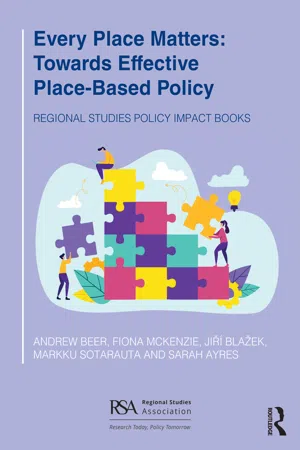
Every Place Matters
Towards Effective Place-Based Policy
Andrew Beer, Fiona McKenzie, Jiří Blažek, Markku Sotarauta, Sarah Ayres
- 80 pages
- English
- ePUB (mobile friendly)
- Available on iOS & Android
Every Place Matters
Towards Effective Place-Based Policy
Andrew Beer, Fiona McKenzie, Jiří Blažek, Markku Sotarauta, Sarah Ayres
About This Book
Across the globe policy makers implement, and academics teach and undertake research upon, place-based policy. But what is place-based policy, what does it aspire to achieve, what are the benefits of place-based approaches relative to other forms of policy, and what are the key determinants of success for this type of government intervention? This Policy Expo examines these questions, reviewing the literature and the experience of places and their governments around the world. We find place-based policies are essential in contemporary economies, providing solutions to otherwise intractable challenges such as the long-term decline of cities and regions. For those working in public sector agencies the success or failure of place-based policies is largely attributable to governance arrangements, but for researchers the community that is the subject of this policy effort, and its leadership, determines outcomes. This Policy Expo explores the differing perspectives on place-based policy and maps out the essential components of effective and impactful actions by government at the scale of individual places.
Frequently asked questions
1.
WHAT IS PLACE-BASED POLICY?

1.1 INTRODUCTION

WHAT IS PLACE-BASED POLICY?
- Coordination of challenges
- Multiple levels of governance
- Collective public good
- Complex policy
- Smart specialisation
- Place leadership
- Shared leadership
- Consensus
- Cross-boundary
- Shared goal
- Community aims
- Co-design
- Social networks
- Social capital
- Links between actors
- Individual agency
- Local institutions
- Alan Scott showed how individual cities and regions can shape national economic growth through their influence on individual technologies.6
- Paul Krugman established ‘the new economic geography’ and showed the ways in which cities and regions linked trade to economic growth.7
- Michael Porter demonstrated how clusters of locally based industries were a driving force in national economies.8
- Ed Glaeser and colleagues set out how the characteristics of individual cities shape growth.9
- Adam Jaffe and colleagues articulated the important role of knowledge spillovers and exchange as a determinant of growth.10
1.2 DEFINING PLACE
Table of contents
- Cover
- Title Page
- Copyright Page
- Contents
- Preamble
- Authors
- Executive Summary
- Key Recommendations
- 1. What is Place-Based Policy?
- 2. What are the Benefits of Place-Based Policy?
- 3. Requirements and Challenges of Place-Based Policy
- 4. Outcomes of Place-Based Policy: What Works and What Does Not?
- 5. Conclusions: Questions Answered, Issues Remaining
- Glossary